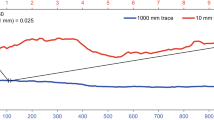Abstract
The hydrogeological effectiveness of fracture sets is determined and evaluated by the fuzzy c-mean and hierarchical clustering. These cluster analyses combine the geological spatial attributes and the hydraulic relevant attributes of fractures. Based on the results of the clustering the fracture set volumes are estimated.


Similar content being viewed by others
References
Bäck C (1994) Fuzzy Clusterverfahren und Validitätsmaße für unscharfe Partitionen. Unveröffentl. Diplomarbeit. Institut für Statistik, TU- Graz, Graz
Barton CC, Larsen E, Page WR, Howard TM (1993) Characterizing fractured rock for fluid-flow, geomechanical and paleostress modelling: methods and preliminary results from Yucca Mountain. Open-File Report 92-269, US Geological survey, Denver, pp 64
Bäumle CC, Hötzl H, Thüringer C, Witthüser K (1998) Untersuchungen zur Einrichtung eines Festgestein-Naturmeßfeldes. AGK 50, Karlsruhe, pp 29–50
Bezdek J (1981) Pattern recognition with fuzzy objective function algorithms. Plenum, New York
Bridges MC (1975) Presentation of fracture data for rock mechanics. In: Proceedings of the 2nd Australia–New Zealand conference on geomechanics, Brisbane. Institution of Engineers, Australia
Davison AC, Hinkley DV (1997) Bootstrap methods and their application. Cambridge Series in Statistical and Probabilistic Mathematics, Cambridge
Hammah RE, Curran JH (1998) Fuzzy Cluster algorithm for the automatic identification of joint sets. Int J Rock Mech Min Sci 35:889–905
Hammah RE, Curran JH (1999) On distance measures for the fuzzy k-means algorithm for joint data. Rock Mech Rock Eng 32(1):1–27
ISRM (1978) Suggested methods for the quantitative description of discontinuities in rock mass. Int J Rock Mech Min Sci 15:319–368
Kulitulake PHW, Wathgala DN, Stephansson O (1993) Joint network modelling with a valiation exercise in Stripa Mine Sweden. Int J Rock Mech Min Sci 30:503–526
Long JCS (1993) Construction of equivalent discontinuum for fracture hydrology. In: Hudson JA (ed) Comprehensive rock engineering, vol 3. Pergamon press, Oxford, pp 241–295
Priest SD (1993) Discontinuity analysis for rock engineering, 1st edn. Chapman and Hall, London, 473 pp
Steinhausen D, Langer K (1977) Clusteranalyse Einführung in Methoden und Verfahren der automatischen Klassifikation. Walter de Gruyter, Berlin New York
Wallbrecher E (1986) Tektonische und gefügeanalytische Arbeitsweisen. Ferdinand Enke Verlag Stuttgart, Stuttgart, 244 pp
Whitten DGA, Brooks JRV (1972) A dictionary of geology. Penguin, Harmondsworth
Acknowledgements
This methodology was developed within a research project supported by the Federal Ministry of Transport, Innovation and Technology of Austria and Joanneum Research Forschungsgesellschaft mbH.
Author information
Authors and Affiliations
Corresponding author
Rights and permissions
About this article
Cite this article
Hofrichter, J., Winkler, G. Statistical analysis for the hydrogeological evaluation of the fracture networks in hard rocks. Environ Geol 49, 821–827 (2006). https://doi.org/10.1007/s00254-006-0177-5
Received:
Accepted:
Published:
Issue Date:
DOI: https://doi.org/10.1007/s00254-006-0177-5




